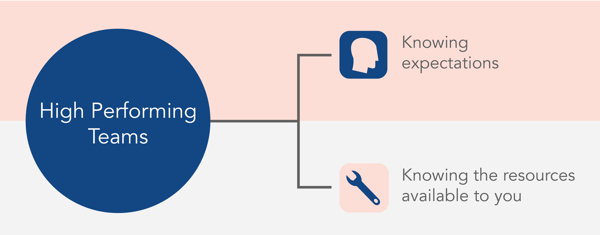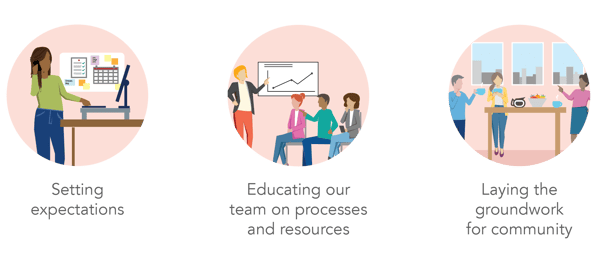Product managers working with teams employing an agile approach to software development face particular challenges when ...
Creating High Performing Teams: Tips for Onboarding, Learning, and Development

Posted by AnswerLab Research on Feb 20, 2020
What do you think of when you imagine an engaging, high-performing work environment? When we consider this environment, we think about starting the work days excited for new challenges, feeling supported by your colleagues, being equipped with the resources to do your best work, and taking advantage of ample opportunities to learn and grow. It may seem obvious, but we’ve found that having a good culture that embraces these core ideas leads to happy team members who are excited to create great experiences for our clients.
At AnswerLab, our work environment is fast paced, and creating high-performing, highly skilled teams is critical to our success and to the success of our clients. To us, what sets high performing teams apart is developed first, in the onboarding process of bringing our newest team members up to speed, and second, in the creation of a learning and development community to continue employee growth for years to come. We have found that high performers and highly skilled professionals are driven to keep growing their skills. We’re always at the front of the pack in terms of learning up on the newest technologies and trying new methods internally to stay ahead of the curve even when our clients aren’t quite ready for them yet. Offering these experiences to our employees not only encourages them to continue growing their skills, but makes development and skill building a core practice for us as a company.
What makes a high performing team?
There are many components to high-performing teams: collaboration, trust, and communication to name a few. But the most important elements to AnswerLab’s foundation are knowing expectations and knowing the resources available to help you meet those expectations.

Through our onboarding process, we want our team members to understand what’s expected of them in their role, what we want them to learn as they onboard, and what strategies and lessons they should bring to their work day after day. But the most critical component that’s often overlooked is understanding what resources are available to make sure they’re delivering on those expectations. As you’re about to start a process, you might ask, “Where do I go when I’m starting this? What’s the first step? Who can I talk to?” and the critical next step is already having an existing venue to get that information. At AnswerLab, we’ve built a culture of help and support so that venue exists in everything we do. One of our core values is to “Jump in and help others.” It’s a spirit of collaboration, not competition, because we want everyone to succeed using their own strengths and skills. Our team knows who they can turn to, where they can find the answers, and when is the right time to ask for help.
How do we do this?
If high performing teams hinge on knowing expectations and knowing the resources available to help you meet those expectations, we have to make sure we touch on these principles time and time again. We’ve built these two tenets into our organization through a two pronged approach: intentional onboarding and ongoing learning and development.
Our onboarding program is led by Research Manager, Megan Sauter, who has developed our researcher onboarding process, vetted tools and standards for teams across the organization, and currently leads our new hire program. Megan shared that it’s important to her that “folks come in knowing what our expectations are, what their first day is going to look like, and what tools might come at them, so they’re prepared and ready to try things out for themselves.” We strive to create a process that teaches our team members what their role is and how to do it, but also how to be a part of our community.
Onboarding is a critical first step, but training doesn’t stop after onboarding. To keep up with evolving expectations, changing relationships and work processes, and continued support, we prioritize learning and development initiatives for our team to grow their skills and benefit from each other’s expertise. This comes in the form of knowledge shares, learning groups, team-building events, and countless tools and resources across teams.
When we think of onboarding and training, we picture people in-person, starting their new position in the office. But at AnswerLab, that’s not always the case. While many tech companies have put an increased emphasis on the in-office culture, we’ve worked towards creating a unique and effective remote experience. In addition to our teams based in San Francisco and New York, over 70% of our team is located remotely across the country. Not only does this help expand the reach of our research to a variety of markets, but it allows us to get the best and the brightest employees around the country regardless of location. We meet them where they’re at, and they enjoy working that way!
"The worst thing is when you start a new job and you don't know what's going on. And that persists. And if you're remote that's even harder because you can't just go to the kitchen and chat with someone as you're getting coffee."
- Megan Sauter, Research Manager, AnswerLab
As a result, we’ve built an organizational culture that successfully engages our remote team, ensures high-quality collaborative work regardless of location, and employs tools to foster internal communication and connection. Community building has to become an essential and very intentional part of your onboarding and organizational culture. When you’re working on a remote team, it’s even harder for impromptu conversations over lunch or in the office. We have to create ways to foster real human connections. We have to create the proverbial water cooler.
Onboarding at AnswerLab
To be successful in our onboarding processes, we have to make sure three things happen:

Setting expectations

When our new hires come in for their first day, they’ve already received a welcome email with everything they need to know about Day 1: their schedule for the day, what they should bring, who they’ll be meeting with, and what to expect right off the bat. We start off with a welcome meeting to get oriented, and if there are others onboarding at the same time, we introduce them there (we like to call these onboarding classes)! New hires receive their “AnswerLab University Curriculum,” a customized document individual to each person that outlines their first three weeks at AnswerLab with all the tasks, trainings, and bits and pieces they’ll need to take care of. This document makes sure our newest team member is not only aware of what’s been put on their calendar and the tasks they have to take care of, but that they have the resources, links, etc. to do them. Throughout this process, we want to set expectations for what’s expected of our team members both in a role-specific way for how to successfully navigate their responsibilities and through more organizational expectations that stem from our core values and business strategies.
Educating our team on processes and resources
A huge part of onboarding at any company is teaching company processes, tools, and best practices, and AnswerLab is no different. We try our best to think about how we can deliver our trainings and educational content in the most effective way. Sitting through PowerPoint presentation after PowerPoint presentation for days on end isn’t the best way to retain information, so we employ a couple different presentation styles, including a flipped classroom approach and a recording of a talk with the opportunity to ask questions later. While it’s important to inform new hires of processes and best practices, it’s even more helpful to explain why we do the things the way we do. It gives additional context of how we’ve developed these processes over time and creates a better understanding of how to best utilize them and suggest improvements over time.

“We don't expect you to leave each training knowing how to tactically complete each task noted, but we hope that the information was provided along with looking at past projects, that you'll have what you need to try it out for yourself!”
- A message from our onboarding materials
In combination with the AnswerLab curriculum, we use Donut, a bot in Slack that allows for customizable just-in-time tasks and reminders. We schedule messages in advance, and our new hire gets reminders, tips, and resources sent to them when the time is right. As someone is about to start working with clients, for example, they might get a message from Donut about resources for kickoff calls or FAQs about our process. Onboarding can be overwhelming, so reminders are thoughtfully programmed to provide information when it's most likely to be useful. This also allows for consistent sharing of resources across teams, while allowing for nuances and customization based on department and role. Once we program it the first time, it runs itself!
Laying the groundwork for community

While setting expectations and learning about processes is a critical part of onboarding, we argue that building community is just as important. During their first week, a new hire is introduced to their onboarding buddy, another AnswerLab team member who serves as a resource and guide throughout their onboarding process. The buddy schedules a couple check-ins in their first couple weeks to answer any questions, share advice, and serve as a mentor and friend. Sometimes this person will be working on the same team as the new hire or it could be someone from a vastly different part of the company! We find this program is extremely valuable for new team members to start building their network of peers.
In addition to role specific competency trainings, we also assign presentations and exercises that showcase AnswerLab’s culture to invite new hires into the fold from Day 1. These include watching video clips of our CEO speaking about AnswerLab’s values at a recent company event or asking them to read through the past couple months of our internal Employee Newsletter to catch up on company news.
Ongoing resource sharing, learning, and community building
We have a strong culture of learning and development that continues throughout someone’s time at AnswerLab. Our research practice has evolved from the days when researchers handled all aspects of a research study. Now, we have specialized roles that make up our project teams. You have your strategist who’s initially spoke with the client about their goals, the Project Manager who is taking care of key recruitment and initial planning phases, the Researcher who’s focused on conducting the research and getting those deep insights, and the Designer who brings it all to life. They are all connecting with each other at different phases of the project as a team approach. Not only do we have people who are doing what they do best, but it also allows for collaboration with others from different backgrounds with varying skills and strengths.
“I don't think there is an ideal AnswerLabber. I think everyone has their own gifts and talents and from a management perspective, I want to help folks grow according to those strengths and really blossom along their career path here.”
- Megan Sauter, Research Manager, AnswerLab
While we maintain knowledge bases, best practices, and tools, our people are our most amazing resource. Having connections with other team members and being able to jump on call to hear their expert point of view on something you’re working on can make a big difference. We truly believe the best way to empower our research team is by learning from peers and colleagues and creating a culture of collaboration across the company. We have various channels for people to ask each other questions, share expertise, work together, and provide peer feedback. And we’re in the process of creating more formal ways of doing this as well through learning and development initiatives!
A couple ways we foster this:
- The AnswerLab Moderator’s Rubric which UXRs can use to evaluate and improve their moderation skills session after session
- Learning lunches and knowledge shares from all aspects and departments within the company
- Donut Break: AnswerLabbers opt-in to get matched with a new person every month to get a coffee in person or chat over video call to meet and connect with each other
- Creating learning groups around topics like time management, productivity, and communication styles for AnswerLab employees across the organization to learn together
- On team meetings, we use video conference breakout rooms to conduct activities and in smaller groups to help open up larger meetings and give everyone a voice.
- People coming together if they’re located in the same area for team-building events
Ongoing community and development for remote teams
We’ve shown you can build a community of people who are exceptional professionals over webcam. Using video calls is incredibly important to building community when you have remote team members! Don’t just rely on the phone. It’s a critical way to create connections, include remote employees in the office, and meet “face to face.” As I’m writing this, one of our San Francisco team members is showing someone around the office on a “tour” using her webcam.

We find that our office culture has to find its way onto online platforms, and for us, Slack plays a big role in that. We use Slack channels to open up conversations on topics from accessibility research to voice and AI technologies to different research methods like diary studies or jobs to be done. These channels allow for open discussion, peer assistance, and mentorship, and are one of the many resources available to our team. We also have community based slack channels on a variety of topics from #topic-dog and #cats to #book-club and #coffee-lovers. We even have an #introverts channel to share experiences and tips on being an introvert in UX research.
That’s not to say in-person time isn’t important! We bring everyone together for an annual multi-day Summit to share knowledge, participate in workshops, and discover ways to deliver even better service to our clients. Additionally, it provides our teams quality time to foster connections and friendships with colleagues. We’ve found there’s power in coming together in-person to learn, collaborate, and recharge especially when you’re spread out across the country.
Top takeaways for creating effective onboarding experiences
Be humble!
You won’t get onboarding right from the start, so be humble and get ready to make adjustments as you experiment with different methods and practices. Look for tools that will help you streamline your process, try out new approaches to learning, and shift your attitude to make this an experience that allows for growth and change.
Listen to your new hires and be empathetic
Not all of your team members are coming from the same place in their career, in life, or even in the same location! Try to understand where they’re coming from and what they’re bringing to your company. This helps inform the kind of training they need, but also clues you in to what their strengths are and how you can utilize them as they become a more integral part of your team. At the end of our onboarding process, every new hire gets a survey about their experience. This can be immensely helpful for iterating on not only your onboarding practices, but maybe even your organizational processes as well.
Think of your company as a community
When onboarding a team member, think outside of just the task requirements of their role. View your company as a community you need to welcome them into and foster that community in everything you do. Ask yourself how you can legitimately connect people in ways that are meaningful and create opportunities for those connections to happen authentically and organically.
...
If you're looking for learning and development tools, download our UX Research Moderator's Guide or read more about strategies for using peer feedback to upskill as a researcher.
Interested in joining our team? Check out our open positions!
AnswerLab Research
The AnswerLab research team collaborates on articles to bring you the latest UX trends and best practices.related insights
stay connected with AnswerLab
Keep up with the latest in UX research. Our monthly newsletter offers useful UX insights and tips, relevant research, and news from our team.